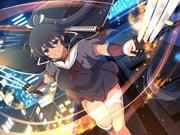koshirae
Japanese sword mountings and fittings.
Hilt and blade components
- Tsuka (柄): sword handle.
- Kashira (頭): end cap (pommel) on the end of the tsuka.
- Shitodome (鵐目): small metal collars in the kashira and/or kurigata.
- Samegawa (鮫皮): ray or shark skin used to cover the bare wooden handle.
- Same-hada (鮫肌): literally the pattern of the ray skin (of samegawa).
- Tsukamaki (柄巻): way (pattern) of wrapping tsuka-ito around the tsuka (see reference).
- Tsuka-ito (柄糸): leather straps or woven cord used in the tsukamaki.
- Mekugi (目釘): peg(s) for securing the handle to the blade.
- Mekugi-ana (目釘穴): hole(s) for the mekugi.
- Menuki (目貫): decorative metal fittings for the tsuka (generally underneath the tsukamaki; see reference).
- Fuchi (縁): hilt collar between the tsuka and the tsuba.
- Tsuba (鐔 or 鍔): sword guard.
- Seppa (切羽): washers or spacers above and below the tsuba to tighten the fittings.
- Habaki (鎺): blade collar.
Scabbard components
- Saya (鞘): sword scabbard.
- Koiguchi (鯉口): mouth of the saya or its fitting.
- Kurigata (栗形): saya fitting for attaching the sageo.
- Sageo (下げ緒): cord used for tying the saya to the obi.
- Kaeritsuno (返角): hook-shaped fitting used to lock the saya to the obi while drawing.
- Kojiri (鐺): end cap on the end of the scabbard.
- Kogai (笄): spike for hair and knot arrangements carried in a pocket of the saya, often paired with kozuka (see reference).
- Kozuka (小柄): decorated utility knife carried in a pocket of the saya, often paired with kogai (see reference).


